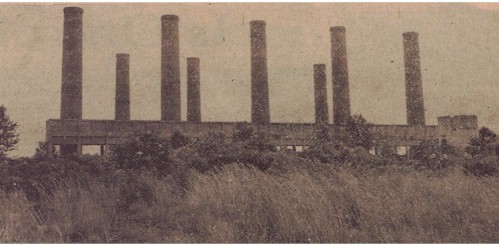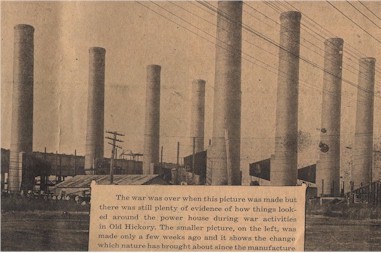|
|||
 |
The
picture to the left has been used by multiple publications when
discussing the Powder Plant Years. This was the Powder Plant
Powerhouse and the nine infamous smoke stacks that could be seen from
miles away. This monstrosity of an operation was located in the
vicinity of where the ABC Auction stands today. Below is a
discussion of the Powder Plant planned construction as well as
"deconstruction" after the war years.
Many of the foundations from the Powder Plant years remain and can be seen during the winter in the wooded part of our plant site as well as along the lake side. |
||
| DIMENSIONS | |||
| The
dimensions of
the proposed Powder Plant and the volume of materials required to
construct and operate it exceeded by 70 times those of any such plant
constructed prior to the war
The plant and village would cover an area more than one and one-half miles wide and three miles long. The power plant would have sixty-eight boilers, each capable of producing 825 horsepower and necessitating the building of nine smokestacks 200 feet high and 15 feet in diameter. In full production, the plant would require 4,500 tons of coal, 100,000,000 gallons of water, 1,500,000 pounds of nitrate of soda, and 675,000 pounds of sulphur per twenty-four hour day. The construct of the plant and village required over 700,000,000 board-feet of lumber, 60,000,000 bricks, and 18,000,000 square feet of composition construction material. The completed plant would consist of 1,112 buildings and would be threaded with 33 miles of broad gauge railroad track and 46 miles of three-foot gauge tramway. The preceding information is taken directly from David Brand's Thesis at Vanderbilt University - "Fill the Empty Shell: The Story of the Government Munitions Project at Old Hickory, Tennessee 1918-1919" – May 1971 |
|||
|
|
|||
| The text on this photo from the 1939 Old Hickory News says," The war was over when this picture was made but there was still plenty of evidence of how things looked around the power house during war activities in Old Hickory. The smaller picture, on the left (pictured below), was made only a few weeks ago and it shows the change which nature has brought about since the manufacture of powder in Old Hickory ceased. | |||
 |
|||
| DECONSTRUCTION Old Hickory News Souvenir Edition 1939 |
|||
| Some
people call them a monument to war's folly. Others say they are
nine silent sentinels guarding the ghosts of thousands of workers who
have gone away. To someone else they are just a familiar bit of
the skyline in Old Hickory, landmarking something which has disappeared.
But the nine huge smoke stacks which rise out of the tangle of heavy undergrowth, standing vigil over the site of the world's largest powder plant, don't say anything. They, in the manner of Ole Man River, just keep standing there as if they meant to stay forever. Workmen may go away, trains may leave, buildings may be torn down, machinery may be sold, but these brick shafts remain. Each year the vicinity has become more desolate, trees and brush have grown closer and wilder, and traces of the sprawling powder plant buildings have disappeared. Yet the nine smoke stacks remain, a last relic of those hectic war days when everything was done on such a big scale. And it wouldn't be at all surprising to find them standing after another twenty years for they were substantially built. May Keep on Standing Another reason that might have a lot to do with keeping them here is that they are the only things which the Nashville Industrial Corporation has been unable to sell, And prospects have not changed any recently. To understand this, it is necessary to know a little bit about the smoke stacks and their erection. Before this sounds too much like a lesson in something or other, it can be told that the information is simply the sort which hundreds of people have wondered about and others might find interesting. A Fortune In Bricks Those smokestacks cost $11,000 a piece. It really is a staggering sum for them when you figure that that means approximately $100,000 in all. Excavations twenty feet deep were necessary for the foundations, which are octagonal in shape and thirty-eight feet in size. They are 200 feet tall measuring from the top of the foundations, with an internal diameter of fifteen feet at the top of the shafts. At the outer base they are twenty one feet and three inches. Wall thickness at top and base are ten inches and twenty-four inches. These chimneys were guaranteed to withstand wind pressures up to one hundred miles per hour, and the influences of ordinary chimney gases and atmosphere, as well as a temperature not exceeding 800 degrees F. They were constructed of perforated radial brick held together with the strongest and most permanent mortar obtainable. And therein lies the reason that the smoke stacks are useless today. No Good Down If these chimneys were torn down, there wouldn't be a whole brick to come out of any of them. Being hollow, like tile, they would break through the bricks and not at the joints, as desired, for the mortar would hold fast. And, added an official of the Nashville Industrial Corporation, owner of the nine smokestacks, if the Chimneys could be brought down with the bricks whole, they couldn't be sold for what it would cost to do the wrecking job. Most of the above data comes from the N.I.C. office which stands at the foot of the smokestacks. Included among the vast files of records is a thick shaft of papers marked "Report Covering Mechanical Division of Old Hickory Powder Plant, Jacksonville, Tenn." This was complied by du Pont engineers shortly after the war and covers practically the entire operations. From this you learn that "it is seldom that one can find an installation containing such an array of mechanical devices for transforming heat into mechanical power as is contained in the Power House at the Old Hickory Smokeless Powder Plant." note: I have found very little documentation on when the smoke stacks were dismantled. If you have any information, please contact us! |
|||
| Where Did It All Go? | |||
| by:
William Newell, 1933, Old Hickory News - Reprinted in 1939 Old Hickory
News Souvenir Edition.
William Newell, in charge of salvage work here, wrote an article for the News six years ago telling of the various uses to which the war time machinery is now being put, and portions of this article are being reprinted below. This will give some idea of the scope of the big work. The immense acid plants which made sulphuric and nitric acid for the gun cotton plant, are now serving in the production of acids for many purposes. One nitric acid plant is now in operation in Chili making acid for a dynamite slant that furnishes explosive for the mining of nitrates, the basis of fertilizers used so extensively in this country. Another furnishes acid for one of the largest manufacturers of drugs and medicines. Still another is operating at a dynamite plant in Alabama that will furnish explosives for coal mining, quarry work and excavating throughout the South. And likewise with the sulphuric acid plants of war days. Two are in Mexico, one making acid to refine petroleum and make gasoline for shipment to this country, and the other to furnish acid for a fertilizer plant. A cotton purification unit, used to prepare cotton for nitrocellulose is now the nucleus of a large kraft paper mill in Louisiana. The actual machines and equipment that changed ordinary cotton linters into gun cotton have been sold to celluloid and lacquer companies. Boilers that furnished steam for these engines are now furnishing steam for coal mines, electric light plants, paper mills, packing houses, cotton oil plants, and salt refineries. Huge mixers that prepared the smokeless powder for the final process are now in service in plants making prepared roofing and tile, insulating compounds and even foodstuffs. Electric generators that supplied current to Old Hickory during operation now furnish current to many cities in the Southwest. The Nashville Industrial Corporation is still operating today. In the last few years more of the original powder plant property has been sold, this time for farm land. And the sale of machinery, now of the smaller nature such as motors and generators continues. |
|||


